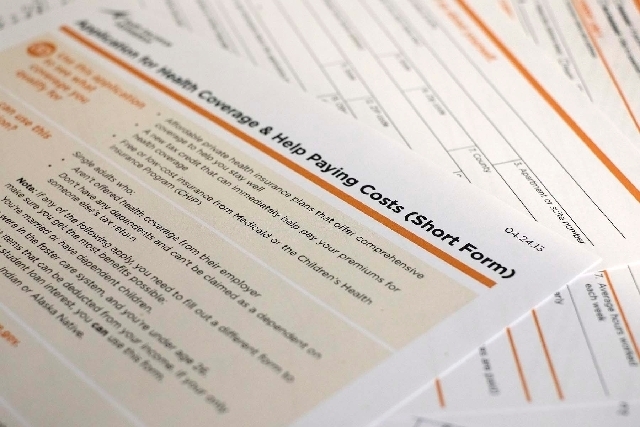Some Nevadans may see higher premiums under Obamacare
Editor’s note: This is one in an occasional series of stories on health care reform.
The Affordable Care Act may not be so affordable for some Nevadans.
The law, commonly called Obamacare, combines benefit mandates and subsidies designed to make health insurance less costly for millions of Americans who now lack coverage.
But observers ranging from state insurance officials to employee benefit consultants say some consumers could see premium increases big enough to price them out of insurance markets. If that happens, fewer people than expected could buy into the system, and that might mean the difference between Obamacare’s success or failure.
It’s not yet clear how dramatic Nevada’s premium increases might be. The state Division of Insurance has received no new product filings for the state’s public insurance exchange, Nevada Insurance Commissioner Scott Kipper said.
Kipper and other division officials declined to estimate what premiums might be, post-reform.
But they did say changes are coming, especially for consumers who buy plans on the individual market, rather than through their employers. Individual buyers make up 15.4 percent of the state’s fully insured market, excluding people who buy through self-insured businesses or government programs.
“They will see something that looks very different from what they have, and it may be priced very differently as a result,” said Glenn Shippey, an actuary in the life and health section of the Division of Insurance. “We’re not sure what that difference is going to be on an individual basis, but it’s important to understand there will be a lot of changes in existing policies.”
VANISHING INDIVIDUAL PLANS
Simply put, if you have an individual insurance plan, it will probably cease to exist. Its replacement will be a minimum benchmark — basic — plan with “essential health benefits” that all Nevada insurers must offer after January. Officials for the Division of Insurance and the Silver State Health Insurance Exchange recommended a benchmark plan similar to Health Plan of Nevada’s comprehensive yet flexible point-of-service plan, which is already the small-group market’s largest plan by enrollment.
The benchmark doesn’t mean every Nevadan must buy point-of-service coverage through Health Plan of Nevada, but it does mean every insurance carrier’s individual plan must meet those coverage levels.
So, whether they need it or not, Nevadans buying individual policies will be covered for maternity care, mental health services, infertility treatments, home health, bariatric surgery, chiropractic care and hearing aids.
Those benefits are common for comprehensive, large-group plans, but rare in individual coverage.
Obamacare also mandates that new plans pay for at least 60 percent of the cost of care they cover. Many individual policies pay just 40 percent of expenses.
The enhanced coverage could boost access to care for thousands of Nevadans, but there is a pricey flip side to those add-ons.
“There’s no way these plans can remain at the (premium) costs they were, because carriers have to provide more benefits in their plan structure,” said Todd Rich, chief deputy commissioner of the Division of Insurance. “They have to price the plans higher.”
Added Shippey: “Individuals in all states are going to see some significant increases, depending on what type of individual we’re talking about. The new laws and rules coming into effect could cause substantial premium increases for some individuals.”
But a richer benefits package isn’t the only factor set to drive up premiums.
New restrictions will limit the difference in premium costs between young, healthy people and older, sicker patients. Nevada law allows insurers to charge older, unhealthy people premiums as much as six times more than younger consumers pay. After January, that gap can only be three times more.
Also gone will be premium reductions for healthier groups. Today, insurers underwrite businesses.
An athletic club staffed with healthy, young people gets a preferred rate, while a bar and grill where older employees live on fatty food gets a maximum rate, said Assurance Ltd. employee benefit consultant Frank Nolimal. He travels Southern Nevada giving businesses a presentation called, “The Good, the Bad and the Ugly of Health Care Reform and Beyond.”
Post-reform, insurers won’t be able to reward or penalize employee behavior. The community rating will be the same for all.
Those rating changes mean young, healthy people could see big increases in premium costs, while unhealthier populations could get a break.
“One side of the fence is subsidizing the other side to keep premiums level,” Nolimal said.
That could be a problem for individual buyers, because they lack tax benefits or employer assistance to pay for coverage, said Robert Zirkelbach, spokesman for the Washington-based trade group America’s Health Insurance Plans.
When someone must buy coverage on their own, they pay the full cost, and that makes them more price-sensitive, Zirkelbach said. That’s why many individuals trade comprehensive coverage for lower premiums.
LESS COVERAGE VS. LOWER PREMIUMS
Toying with that trade-off between less coverage and lower premiums could affect whether Obamacare works.
“The positive is that people are getting more benefits, and they’ll pay less out-of-pocket,” Zirkelbach said.
“But any time you add new benefits to a policy, you add to the cost of coverage. There’s a pretty broad agreement that, for these reforms to work, we need broad participation in the system, particularly among the younger and healthier, to offset the costs of those with high health-care needs. To the extent new mandates increase costs for younger people, they may price them out of the market altogether. That will drive up costs for everyone.”
Division of Insurance officials said it’s too early to tell how much premiums could change in January. And representatives of the state’s two biggest insurers, UnitedHealth Group and Anthem Blue Cross Blue Shield, either declined to comment or didn’t respond to a request for comment.
Advocacy groups and lawmakers have taken a stab at guesstimating, though. Their predictions vary wildly.
FEDERAL SUBSIDIES
As far back as 2009, Anthem officials crunched the numbers and said premiums for Nevada members with the company’s individual policies would rise 85 percent on average. For small businesses, the typical premium increases would be 70 percent.
Some groups would be hit harder than others: For a healthy, 25-year-old male, the monthly premium on an individual plan with a $2,500 deductible and comprehensive pharmaceutical coverage would jump 115 percent, from $119 to $257. A family of four in average health would pay 61 percent more, with premiums rising from $674 to $1,088.
But a 60-year-old couple in poor health would see an 11 percent decline, as monthly charges fell from $1,741 to $1,558.
In March 2012, a study prepared for the state by Massachusetts-based Gorman Actuarial found that individual-market premiums in Nevada could rise 11 percent to 30 percent on average, though federal subsidies could blunt that blow for lower-income consumers.
A January report in Contingencies, the American Academy of Actuaries’ publication, also predicted that people 21 to 29 will pay 42 percent higher premiums nationwide, while those 30 to 39 can expect to shell out 31 percent more. What’s more, adults 21 to 29 making $25,000 or more a year can expect to pay more.
An April study by consulting firm Milliman for America’s Health Insurance Plans found that a healthy 27-year-old U.S. male could see an average 149.8 percent annual premium jump, from $1,414 to $3,532.
Federal subsidies could change that calculation: A young man earning less than $25,000 or so a year would see premiums drop by 25 to 60 percent, thanks to tax breaks, while one who earns about $42,000 a year or more would see premiums spike 169 percent.
For an unhealthy, 57-year-old woman, yearly premiums could tick up 4.1 percent, from $7,892 to $8,214, though federal aid would bring down premiums 51 percent or more for women making less than roughly $42,000 a year.
‘GRUMBLINGS AND RUMORS’
Policymakers are now weighing in. U.S. Health and Human Services Secretary Kathleen Sebelius didn’t put numbers on it, but she told the Wall Street Journal in March that “there may be a higher cost associated with” moving individual buyers into a “fully insured product for the first time.”
Sebelius added that some men and younger customers could see rates rise, while women and older customers might enjoy rate drops.
Though the state Division of Insurance wouldn’t offer its own analysis, it is issuing caveats. Adam Plain, an insurance regulatory liaison with the agency, cautioned that premium studies use differing methods, and may rely on distinct regional demographic data that don’t apply in every market. Plus, assumptions used in studies may be outdated because new regulations are added daily to the books.
Employee benefits experts give mixed reviews to existing studies.
Nolimal said a 115 percent premium jump for younger, healthier consumers is “very close” to estimates he hears .
Quincy Branch, president and CEO of Branch Benefits Consultants in Las Vegas, said he hears “grumblings and rumors,” yet nothing concrete from carriers.
New premiums could become more concrete in coming weeks.
Insurers will begin filing plans with the Division of Insurance late this month and in early June. The division will make those plans available to the public shortly after they receive them, though Kipper said that won’t mean the agency has signed off on the premiums. He said the division would study rate requests to ensure they’re not excessive, inadequate or unfairly discriminatory. The approval process for each plan could take two to 10 weeks, depending on complexity. Plans would take effect Jan. 1.
Large-group markets for bigger employers will see fewer effects. Those plans typically offer the kind of comprehensive coverage just now coming to individual and small-group plans, and they’re spared community- and age-rating changes for two years, Nolimal said.
Self-insured companies, which pay health costs directly, are exempt from many mandates, though they often offer richer coverage than individual plans.
Still, Rich said the agency believes small and large groups will also feel the effects of new plan mandates, if not as much as individual buyers will.
Contact reporter Jennifer Robison at jrobison
@reviewjournal.com or 702-380-4512.
Follow @J_Robison1 on Twitter.




























